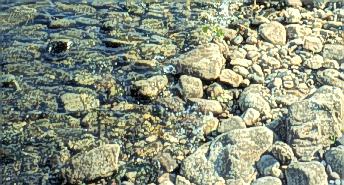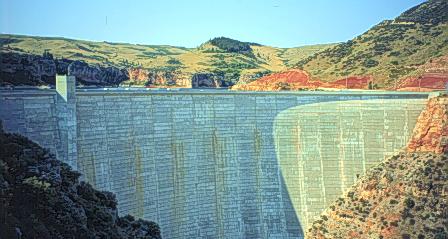Aquatic Invertebrates of Montana
Bighorn River

The Bighorn River below Yellowtail Afterbay Dam is frequently called one of the best trout streams in the world. That might be true. I have seen some pretty good days there. See the fishing reports by the Big Horn Trout Shop or Last Stand Outfitters for more information.
Tubifex Summary
As of January 28, 1997, I have 7 samples from 5 sites along the Bighorn River and I have prepared 86 slides and closely examined 453 worms. Sites include above the Afterbay Dam (104), below the Afterbay Dam (105 and 290), the Lind site (106), the Bighorn site (107 and 293) and the Two Leggins site (108).
The abundant occurrence of Tubifex in cold, regulated tailwaters seems to be a good rule. The Bighorn River is no exception. Tubifex is abundant here. Conditions here are so well suited for Tubifex that it occurs even in boulder and cobble substrates. I have so far found only 2 good predictors for Tubifex in Montana: cold or cool water and few other species present. Yellowtail Dam provides both conditions. Total invertebrate life in the river is very high, but the number of species is very low.
Total oligochaete density is very high everywhere, except it is a little lower near the Afterbay Dam. This could be purely due to substrate size- worms cannot burrow in rocks, they must live around them. The percent Tubifex stays fairly steady around 25% from the Afterbay Dam to the Bighorn access site. By the Two Leggins site, Tubifex drops to less than 7% of the total worms. Ilyodrilus templetoni appears for the first time and it makes up about 18% of the total worms. This transition from Tubifex to Ilyodrilus appears to be a common in warmer rivers. Tubifex is likely to occur above the Afterbay Dam also, but conditions are poor for shallow water sampling due to the fluctuating water level. I found only a few immature worms, 26% are probably Tubifex.

The above picture shows the substrate below Yellowtail Afterbay Dam. Tubifex lives in abundance here, even with the large substrates and rapid current.
Aquatic Oligochaete species list
- Eiseniella tetraedra (Savigny)
- Enchytraeidae
- Ilyodrilus templetoni (Southern) (lower section only)
- Tubifex tubifex (Muller)
- Limnodrilus claparedianus Ratzel (lower section only)
- Limnodrilus hoffmeisteri Claparede
- Limnodrilus udekemianus Claparede
- Ophidonais serpentina (Muller)
- Nais sp.
Tributaries
As far as I know, none of the few permanent tributaries in the area are important to trout. They are all warm prairie streams with prairie communities that are unlikely to contain Tubifex, at least during the warm season.
- Lime Kiln Creek- This flashy small stream enters the Yellowtail Afterbay. It can carry enough sediment during flash floods to cloud the whole river. A large, mid-summer sample at Fort Smith found it to be full of life, but the community had very few oligochaetes and no Tubifex. Based on the warm temperature and large numbers of predators, Tubifex is unlikely here. Ilyodrilus templetoni, on the other hand, does occur here, as is typical of warmer streams.
Whirling Disease Risk Assessment
Based on the worm data and the current state of knowledge, the Bighorn River should be at extreme risk for Whirling disease. The complete loss of the very popular rainbows in the river would seem likely. Every effort should be made by persons entering this isolated trout fishing area, not to bring the parasite with them! I believe, as do many other fishery biologists, that transporting infected fish, dead or alive, is the biggest risk. You would probably need to carry a huge volume of mud to get any spores. It is, however, always a good practice to cleanup very well before traveling between drainages.
Tubifex Research Needs and Opportunities
I see no further Tubifex research needs in the area at this time. Should the area become infected with the parasite, it will provide a good temperature gradient to examine the development and release of the parasite.
29 JAN 1997 D.L. Gustafson
Back to the Montana Tubifex Summary by River System

